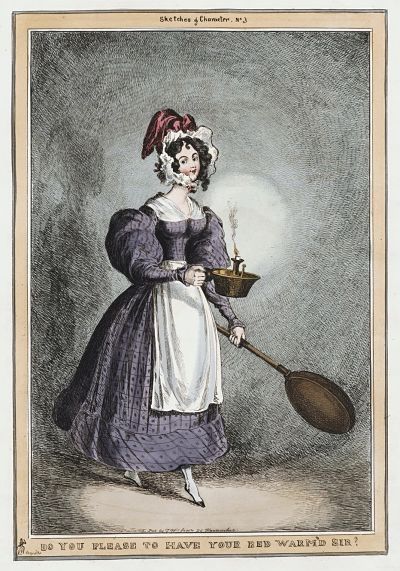 Hanging a warming pan near the hearth is not just a decorator's idea. The fireplace was always a sensible place for it, so it could easily be filled with glowing coals or wood embers before being taken away to warm the bed. Using a hot stone or brick heated at the fireside is one way of carrying warmth from the hearth into bed. By the 1500's people were also taking pans filled with smouldering fuel from the fire itself.
Hanging a warming pan near the hearth is not just a decorator's idea. The fireplace was always a sensible place for it, so it could easily be filled with glowing coals or wood embers before being taken away to warm the bed. Using a hot stone or brick heated at the fireside is one way of carrying warmth from the hearth into bed. By the 1500's people were also taking pans filled with smouldering fuel from the fire itself.Bed warmers were a practical necessity in cold climates until modern heating systems came into existence.
Using a hot stone or brick heated at the fireside is one way of carrying warmth from the hearth into bed. By the 1500´s people were also taking pans filled with smouldering fuel from the fire itself.
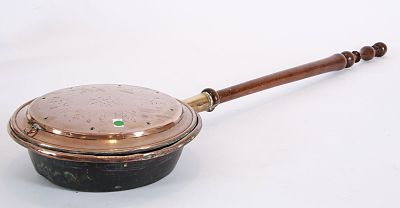 The best way of taking the chill off the bed in the days before hot-water bottles was to slide a warming pan between the sheets. A warming pan is a circular shaped vessel with a lid and a long wooden or metal handle that played an important role in the household. The circular box was made from copper, brass or occasionally silver into which hot embers, coal or burning charcoal were placed. There were holes at the top to ensure that it burned evenly.
The best way of taking the chill off the bed in the days before hot-water bottles was to slide a warming pan between the sheets. A warming pan is a circular shaped vessel with a lid and a long wooden or metal handle that played an important role in the household. The circular box was made from copper, brass or occasionally silver into which hot embers, coal or burning charcoal were placed. There were holes at the top to ensure that it burned evenly.A warming pan, sometimes known as a bed warmer nowadays, was a valuable family possession handed down from generation to generation, but not so expensive that it was only for the rich. If you were very wealthy you might have a silver one, or a richly decorated copper warmer. Some of the most ornate warming pans have an elaborate pattern of perforations incorporated in the design.
Warming pans served two purposes namely:
They were used to warm up beds where the pan would be run up and down the sheet just as if it were a large iron
Pots containing food would be placed on them so that they were kept warm.
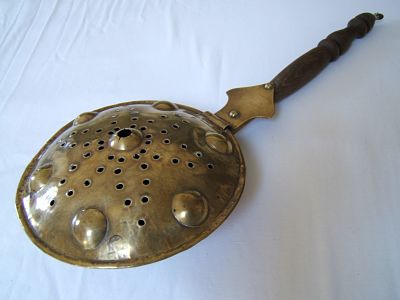 It was once the custom of a servant to be sent to bed in order to warm the master’s sheets, a pastime less dangerous, perhaps, than using a bed warmer, because it is clear from a study of early household inventories that many beds were destroyed by fire.
It was once the custom of a servant to be sent to bed in order to warm the master’s sheets, a pastime less dangerous, perhaps, than using a bed warmer, because it is clear from a study of early household inventories that many beds were destroyed by fire.Brass warming pans date from 1400, and the pans were made from Dutch brass.
Copper warming pans became popular during the 1700's and were manufactured in company with brass pans well into the reign of Queen Victoria, Many of the original turned wood handles became affected by woodworm, so it is not uncommon today to find an old pan with a replacement handle.
These long handled warming pans were gradually replaced in the 1800´s by copper and brass hot water containers, which in turn were themselves replaced by stoneware hot water bottles. The earliest examples are large, often with a brass or iron handle, whilst the Victorian warming pans are smaller with a wooden handle.
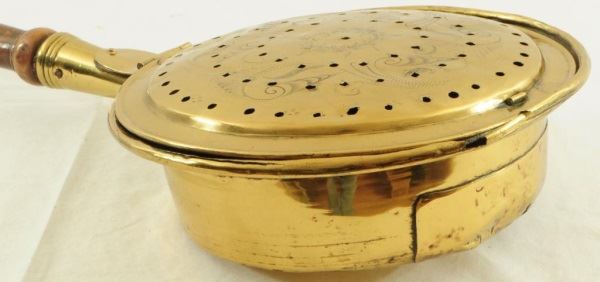
The lids of the warming pans were often covered with chased, embossed and engraved decoration, conforming to the style of the period and sometimes a pierced hinged lid. The ornament also included figured motifs that where mostly animals, and there were usually inscriptions as well. The earliest examples are large, often with a brass or iron handle, whilst the Victorian warming pans are smaller with a wooden handle.
 But not all warming pans had pierced patterns. This difference would have been crucial for the servant or housewife using the pan. With air holes, the embers would keep smouldering, the heat would last longer, but the bed would probably smell of fumes and there was an increased risk of scorching the sheets. The smell was not always of wood or coal; in some parts of the UK it was burning peat.
But not all warming pans had pierced patterns. This difference would have been crucial for the servant or housewife using the pan. With air holes, the embers would keep smouldering, the heat would last longer, but the bed would probably smell of fumes and there was an increased risk of scorching the sheets. The smell was not always of wood or coal; in some parts of the UK it was burning peat.Warming pans date from 1400, when the pans were made from Dutch brass. Copper warming pans became popular during the 1700`s and were manufactured in company with brass pans well into the reign of Queen Victoria, A warming pan was even the excuse for a revolution in 1688 when a fraudulent baby Prince of Wales was smuggled into the Queen’s bed in one, or so it was assumed.
A warming pan, sometimes known as a bed warmer nowadays, was a valuable family possession handed down from generation to generation, but not so expensive that it was only for the rich. If you were very wealthy you might have a silver one, or a richly decorated copper warmer. Some of the most ornate warming pans have an elaborate pattern of perforations incorporated in the design.
Woodworm affected many of the original turned wood handles, so it is not uncommon today to find an old pan with a replacement handle. Always look for signs of wear, as a pan filled night after night with hot coals should show signs of distress. Many of the pans fell from off the wall, so it is not unusual to find pans flattened on the bottom edge.
Because of the fire risk and for convenience, these long handled warming pans were gradually replaced in the 1800´s by copper and brass hot water containers. Initially these were made from copper and retained the long wooden handle, but eventually these were replaced by brass or copper carrying handles. As time progressed ceramic hot water bottles were introduced which themselves were replaced by the rubber hot water bottle.

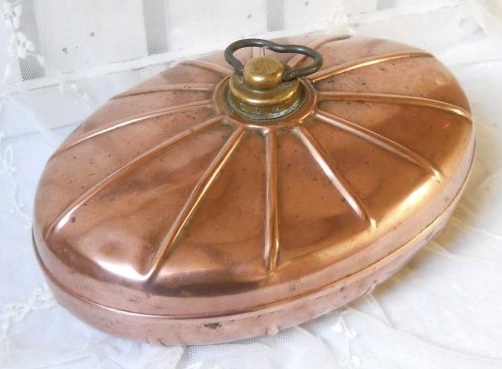

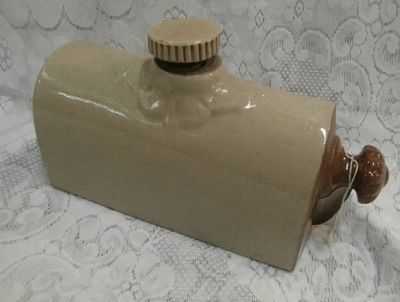
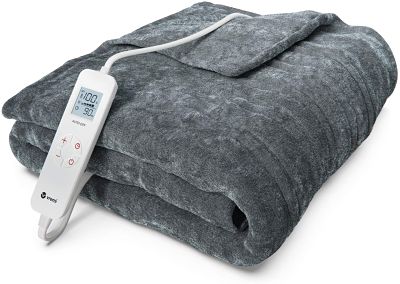 A long handle warming pan was even the excuse for a revolution in 1688 when a fraudulent baby Prince of Wales was smuggled into the Queen’s bed in one, or so it was assumed.
A long handle warming pan was even the excuse for a revolution in 1688 when a fraudulent baby Prince of Wales was smuggled into the Queen’s bed in one, or so it was assumed.Woodworm affected many of the original turned wood handles, so it is not uncommon today to find an old pan with a replacement handle. Always look for signs of wear, as a pan filled night after night with hot coals should show signs of distress. Many of the pans fell from off the wall, so it is not unusual to find pans flattened on the bottom edge.
The ubiquitous electric blanket and central heating has completely replaced the hot water bottle and the copper/brass bed warmer, but I am not sure that many people will collect and hang an old electric blanket on their wall for decoration.
